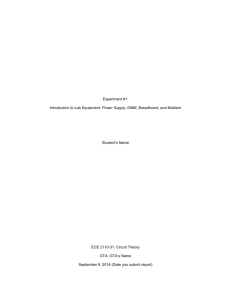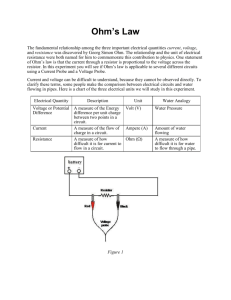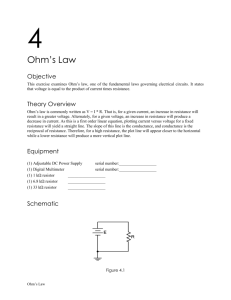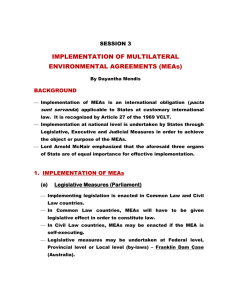Experiment 3
advertisement
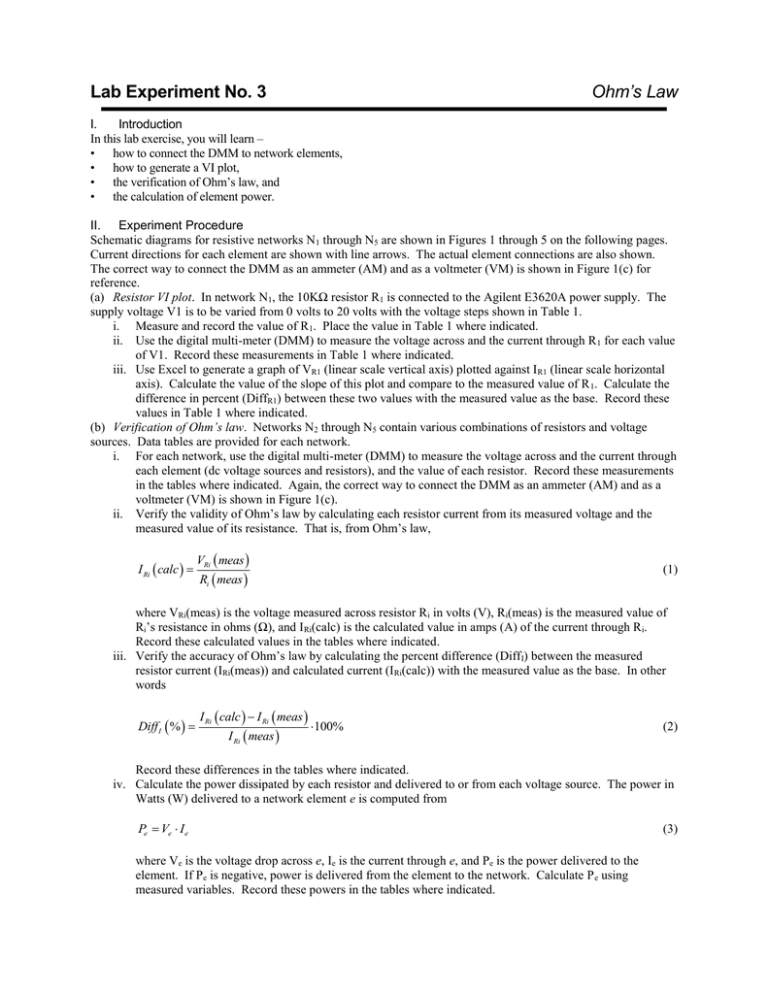
Ohm’s Law Lab Experiment No. 3 I. Introduction In this lab exercise, you will learn – • how to connect the DMM to network elements, • how to generate a VI plot, • the verification of Ohm’s law, and • the calculation of element power. II. Experiment Procedure Schematic diagrams for resistive networks N1 through N5 are shown in Figures 1 through 5 on the following pages. Current directions for each element are shown with line arrows. The actual element connections are also shown. The correct way to connect the DMM as an ammeter (AM) and as a voltmeter (VM) is shown in Figure 1(c) for reference. (a) Resistor VI plot. In network N1, the 10KΩ resistor R1 is connected to the Agilent E3620A power supply. The supply voltage V1 is to be varied from 0 volts to 20 volts with the voltage steps shown in Table 1. i. Measure and record the value of R1. Place the value in Table 1 where indicated. ii. Use the digital multi-meter (DMM) to measure the voltage across and the current through R 1 for each value of V1. Record these measurements in Table 1 where indicated. iii. Use Excel to generate a graph of VR1 (linear scale vertical axis) plotted against IR1 (linear scale horizontal axis). Calculate the value of the slope of this plot and compare to the measured value of R 1. Calculate the difference in percent (DiffR1) between these two values with the measured value as the base. Record these values in Table 1 where indicated. (b) Verification of Ohm’s law. Networks N2 through N5 contain various combinations of resistors and voltage sources. Data tables are provided for each network. i. For each network, use the digital multi-meter (DMM) to measure the voltage across and the current through each element (dc voltage sources and resistors), and the value of each resistor. Record these measurements in the tables where indicated. Again, the correct way to connect the DMM as an ammeter (AM) and as a voltmeter (VM) is shown in Figure 1(c). ii. Verify the validity of Ohm’s law by calculating each resistor current from its measured voltage and the measured value of its resistance. That is, from Ohm’s law, I Ri calc VRi meas (1) Ri meas where VRi(meas) is the voltage measured across resistor Ri in volts (V), Ri(meas) is the measured value of Ri’s resistance in ohms (Ω), and IRi(calc) is the calculated value in amps (A) of the current through R i. Record these calculated values in the tables where indicated. iii. Verify the accuracy of Ohm’s law by calculating the percent difference (Diff I) between the measured resistor current (IRi(meas)) and calculated current (IRi(calc)) with the measured value as the base. In other words Diff I % I Ri calc I Ri meas I Ri meas 100% (2) Record these differences in the tables where indicated. iv. Calculate the power dissipated by each resistor and delivered to or from each voltage source. The power in Watts (W) delivered to a network element e is computed from Pe Ve I e where Ve is the voltage drop across e, Ie is the current through e, and Pe is the power delivered to the element. If Pe is negative, power is delivered from the element to the network. Calculate P e using measured variables. Record these powers in the tables where indicated. (3) III. Lab Report The report for this lab experiment must be word-processed and contain the following items – • Title Page. • Introduction. • Procedure. • Results. • Discussions. (a) Suggest useful applications for Ohm’s law as studied in this experiment. • Conclusion. (a) Are all measured and calculated currents within resistor tolerance? List those that are not. (b) Explain how resistor variations produce differences between measured and calculated currents. (c) Which method of determining resistor currents (measurement versus calculation) yields more accurate results? Explain. (d) Which method is more convenient? Explain. (e) Explain how you would convince your boss (via a sales pitch) to use on method over the other. Strengthen your sales pitch with solid engineering practice and mathematical reasoning. • Appendix. • References. IV. 1. Resistive Networks Network N1. 1 Agilent E3620A V1 V1 N1 V2 10K R1 2 R1 1 2 (a) (b) DMM (AM) IV1 1 IR1 DMM (AM) DMM (VM) VV1 V1 R1 VR1 DMM (VM) 10K 2 (c) Figure 1 (a) Network N1 (b) Component connections (c) DMM connections Table 1 Measured variables from N1 V1 (V) VR1 (V) IR1 (A) Slope of VI plot (Ω) DiffR1 (%) 0.0 2.5 5.0 7.5 10.0 12.5 15.0 17.5 20.0 R1(meas) (Ω) 2. Network N2. Agilent E3620A R1 1 V1 2 V2 1K V1 R2 9V 2K 1 4 R3 R1 N2 4 3K R3 3 2 3 R2 (a) (b) Figure 2 (a) Network N2 (b) Component connections Table 2 N2 measured and calculated variables Element Specified value R1 1KΩ R2 2KΩ R3 3KΩ V1 9V Measure value Ve(meas) (V) Ie(meas) (A) Ie(calc) (A) DiffI (%) N/A N/A Pe (W) 3. Network N3. Agilent E3620A V1 V2 1 V1 5V R1 R2 R3 R1 300K 150K 120K 1 2 N3 R2 2 R3 (b) (a) Figure 3 (a) Network N3 (b) Component connections Table 3 N3 measured and calculated variables Element Specified value R1 300KΩ R2 150KΩ R3 120KΩ V1 5V Measure value Ve(meas) (V) Ie(meas) (A) Ie(calc) (A) DiffI (%) N/A N/A Pe (W) 4. Network N4. 1 Agilent E3620A V1 V1 3V R1 47K 2 V2 5V N4 V2 R2 R3 100K 1 20K R1 R2 3 2 3 R3 (a) (b) Figure 4 (a) Network N4 (b) Component connections Table 4 N4 measured and calculated variables Element Specified value R1 47KΩ R2 20KΩ R3 100KΩ V1 V2 Measure value Ve(meas) (V) Ie(meas) (A) Ie(calc) (A) DiffI (%) 3V N/A N/A 5V N/A N/A Pe (W) 5. Network N5. Agilent E3620A V1 1 R1 R2 2 10K V1 10V N5 V2 3 30K R3 3K 15V V2 1 2 R1 4 R2 3 R3 4 (a) (b) Figure 5 (a) Network N5 (b) Component connections Table 5 N5 measured and calculated variables Element Specified value R1 10KΩ R2 30KΩ R3 3KΩ V1 V2 Measure value Ve(meas) (V) Ie(meas) (A) Ie(calc) (A) DiffI (%) 10V N/A N/A 15V N/A N/A Pe (W)


